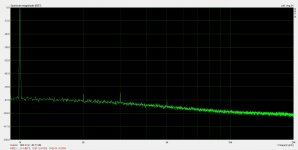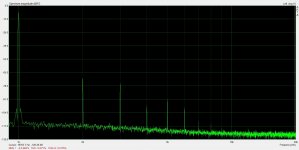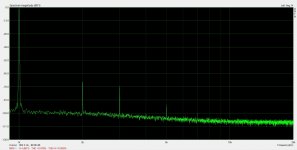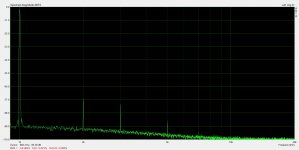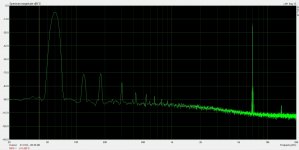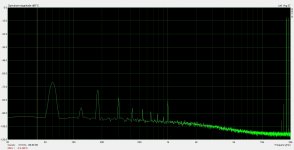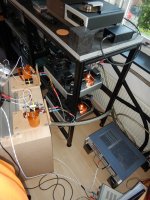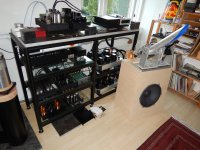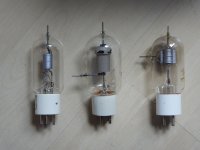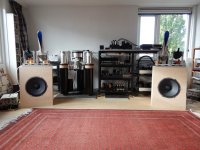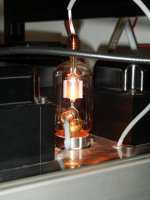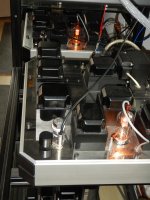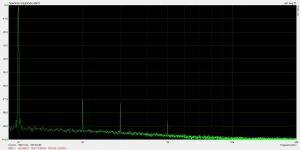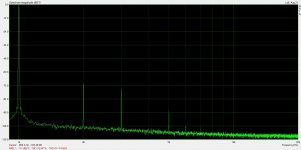The IXTK8N150L is quite a beast. So far my power MOSFET’s are still running. I’ll keep this one in mind in case I need a replacement.
Regards, Gerrit
Regards, Gerrit
Gerrit, what voltage and current are you running?
For this pass device, input voltage is going to be more than 800V and output current is going to be 250mA or more on audio peaks per output tube, plus the other small currents in the amp. I've done my best to make startup not be stressful to the pass device (output tube bias is servo controlled and starts at 0V, which translates to 20mA or so on power-up, slowly increasing to 125mA in about 40 seconds).
I shouldn't see high voltage and current across the pass device at the same time with the way I am running this. A smaller fet should work, but it feels good having the extra insurance. It has been through a lot of power up/down cycles now and long, loud listening sessions. It seems quite reliable.
For this pass device, input voltage is going to be more than 800V and output current is going to be 250mA or more on audio peaks per output tube, plus the other small currents in the amp. I've done my best to make startup not be stressful to the pass device (output tube bias is servo controlled and starts at 0V, which translates to 20mA or so on power-up, slowly increasing to 125mA in about 40 seconds).
I shouldn't see high voltage and current across the pass device at the same time with the way I am running this. A smaller fet should work, but it feels good having the extra insurance. It has been through a lot of power up/down cycles now and long, loud listening sessions. It seems quite reliable.
My PSU delivers 600 VDC @ 600 mA (stable within 1%). Right now I’m using a refurbished MOSFET from a HP Server PSU. This one is not designed for linear use, but so far it’s reliable with 1000 uF on the input side and 200 uF on the output.
I use a slow start circuit (series resistor with relay) and a 60 sec. timer on the bias setting.
Regards, Gerrit
I use a slow start circuit (series resistor with relay) and a 60 sec. timer on the bias setting.
Regards, Gerrit
I did some measurements with the 100TH. My B+ still isn't at 750V like it eventually will be, so power output is limited for now. Clipping started at 27.4W.
Here is a tabular summary:
100mW: 0.012%
500mW: 0.016%
1W: 0.021%
2W: 0.030%
5W: 0.052%
10W: 0.071%
20W: 0.084%
27.4W: 0.15%
It's got a little less distortion than the 826 except at 10W. The 826 had something weird happen where THD basically didn't increase from 5 to 10 Watts. The 100TH increases steadily.
I also noticed that I'm clipping symmetrically but I'm hitting the positive rail on the mosfet grid driver. I'm going to have to throw another 48V supply on the stack. When I get the 750V supply finished, I'l increase q current a bit and we should have over 30W out.
Here is a tabular summary:
100mW: 0.012%
500mW: 0.016%
1W: 0.021%
2W: 0.030%
5W: 0.052%
10W: 0.071%
20W: 0.084%
27.4W: 0.15%
It's got a little less distortion than the 826 except at 10W. The 826 had something weird happen where THD basically didn't increase from 5 to 10 Watts. The 100TH increases steadily.
I also noticed that I'm clipping symmetrically but I'm hitting the positive rail on the mosfet grid driver. I'm going to have to throw another 48V supply on the stack. When I get the 750V supply finished, I'l increase q current a bit and we should have over 30W out.
Attachments
Wow, incredible measurements...
How does it sound with your speakers?
I am still collecting transmitters for an HK54 / 35TG / 35T build, got this pair of 35TG today, untested, took a gamble and got lucky, NOS from 1945.


And still rocking away with that 801A amp.
How does it sound with your speakers?
I am still collecting transmitters for an HK54 / 35TG / 35T build, got this pair of 35TG today, untested, took a gamble and got lucky, NOS from 1945.


And still rocking away with that 801A amp.
Nice! I've done very well gambling on tubes. I just have a price in mind for what I'm willing to pay for a tube without guarantee and another price for guaranteed tubes. Even if I have to eat it occasionally, I've come out ahead.
I'm playing into a '70s Sansui speaker (SP-200). I picked up the pair for $30. They are my garage speakers. They are really efficient, so this amp can probably blow them out if I'm not careful. They sound great until I get the volume up too high. Then nothing sounds good and my ears just hurt, lol. This is definitely just more power than I need with those speakers. Really, it sounds great and is very much in control of the speakers.
I've got some efficient PA speakers (JBL JRX-215). Maybe I'll give those a shot. They are a little less efficient but they can handle 250W so this amp should not present any danger to them.
I'm playing into a '70s Sansui speaker (SP-200). I picked up the pair for $30. They are my garage speakers. They are really efficient, so this amp can probably blow them out if I'm not careful. They sound great until I get the volume up too high. Then nothing sounds good and my ears just hurt, lol. This is definitely just more power than I need with those speakers. Really, it sounds great and is very much in control of the speakers.
I've got some efficient PA speakers (JBL JRX-215). Maybe I'll give those a shot. They are a little less efficient but they can handle 250W so this amp should not present any danger to them.
Amazing looks, if it wasn't for the exposed contacts carrying high voltage I would swap my GM70 project for this one 🙂
Very low THD distortion, can you measure IMD 60Hz / 7kHz and 18kHz / 19kHz?
These are at 1W output.
Attachments
Hi SpreadSpectrum,
those 35TG's are really nice tubes.
I've made an (A2, zero-bias, parafeed) amp with them years ago. Input/driver is a 6FJ7. Works very nice. It was designed as a full range amp but currently in use only to power the woofers.
Pictures included. And these are daylight pictures without photoshopping ! They become really red.
Currently i'm exploring the near equivalents (SFR E.556, HK54, UH35, DET18) but only the HK54 seems to be available; the rest is simply luck when you can source them.
Good luck with your built; they're worth it.
Regards, Reinout
((if someone has those Eimac UH35's or SFR E.556's please contact me....would love to bring together those orphans to working pairs))((and i'm sure there are other versions out there......))
those 35TG's are really nice tubes.
I've made an (A2, zero-bias, parafeed) amp with them years ago. Input/driver is a 6FJ7. Works very nice. It was designed as a full range amp but currently in use only to power the woofers.
Pictures included. And these are daylight pictures without photoshopping ! They become really red.
Currently i'm exploring the near equivalents (SFR E.556, HK54, UH35, DET18) but only the HK54 seems to be available; the rest is simply luck when you can source them.
Good luck with your built; they're worth it.
Regards, Reinout
((if someone has those Eimac UH35's or SFR E.556's please contact me....would love to bring together those orphans to working pairs))((and i'm sure there are other versions out there......))
Attachments
Last edited:
I hope you find the matches you are looking for.
I've noticed that with the 100T variants I own, the older tubes have the finned anodes and they start glowing red at 60% or less of max dissipation. Newer ones were made of a different material and without fins. They don't begin to glow red until 85%+ max dissipation. I try to pick up the finned anode tubes when I can since they just look better.
It looks like one of your tubes has a graphite anode? I wonder how much color that one gives off compared to the others.
I've noticed that with the 100T variants I own, the older tubes have the finned anodes and they start glowing red at 60% or less of max dissipation. Newer ones were made of a different material and without fins. They don't begin to glow red until 85%+ max dissipation. I try to pick up the finned anode tubes when I can since they just look better.
It looks like one of your tubes has a graphite anode? I wonder how much color that one gives off compared to the others.
Good morning SpreadSpectrum,
got about 10 different versions of the 35TG:
- different anode structure (earlier ones only were cylinders whereas later ones were "capped"; mu changes from 30 to 39);
- different anode material (still metal);
- different fins;
- different sockets;
- different connection anode to lead-out;
And that is the same with the 35T.
The SFR e.556 has a carbon structure. No red anode while playing but you can look at the squirrel cage grid and the filament itself through the ventilation holes. Filament is very bright.
And although i'm not using your 100TH i've seen almost the same version with that tube as "my" 35TG's. Philips made them for a short time with a carbon anode structure.
All nice tubes. Sourced most of my stuff in the USA and like all tubes with these brittle (thoriated tungsten) filaments your chances of getting that stuff safely transatlantic is about 50/50. But if you have them and they're in working order they last for ages. I'm running my 35TG's for years now (about 10 ?!); still the same pair which i think is pretty impressive as i took these amplifiers also to some audio fairs.
Regards, Reinout
got about 10 different versions of the 35TG:
- different anode structure (earlier ones only were cylinders whereas later ones were "capped"; mu changes from 30 to 39);
- different anode material (still metal);
- different fins;
- different sockets;
- different connection anode to lead-out;
And that is the same with the 35T.
The SFR e.556 has a carbon structure. No red anode while playing but you can look at the squirrel cage grid and the filament itself through the ventilation holes. Filament is very bright.
And although i'm not using your 100TH i've seen almost the same version with that tube as "my" 35TG's. Philips made them for a short time with a carbon anode structure.
All nice tubes. Sourced most of my stuff in the USA and like all tubes with these brittle (thoriated tungsten) filaments your chances of getting that stuff safely transatlantic is about 50/50. But if you have them and they're in working order they last for ages. I'm running my 35TG's for years now (about 10 ?!); still the same pair which i think is pretty impressive as i took these amplifiers also to some audio fairs.
Regards, Reinout
My luck with getting good transmitting tubes has been about 50/50 as well but only a small portion have been filament breakage, most of the bad ones were just gassy.
Maybe the gassy ones can be recovered if they are heated for a few hours ?My luck with getting good transmitting tubes has been about 50/50 as well but only a small portion have been filament breakage, most of the bad ones were just gassy.
Getter/zirconium plates that absorbs gas can release the gas after prolonged storing, and will reabsorb of given a chance to work.
I finally got my Hammond power transformer and got the HV power supply up to 750V (125mA), which is where I want to run all of these 100T variants that I have accumulated to test.
First up was the 100TH. I've attached the measured results.
Summary:
100mW: 0.028%
500mW: 0.017%
1W: 0.021%
2W: 0.031%
5W: 0.051%
10W: 0.069%
20W: 0.078%
30W: 0.17%
35W: 0.29%
Clipping really starts at 35W, you can see sharp peaks starting to form on the 100TH grid waveform.
First up was the 100TH. I've attached the measured results.
Summary:
100mW: 0.028%
500mW: 0.017%
1W: 0.021%
2W: 0.031%
5W: 0.051%
10W: 0.069%
20W: 0.078%
30W: 0.17%
35W: 0.29%
Clipping really starts at 35W, you can see sharp peaks starting to form on the 100TH grid waveform.
Attachments
-
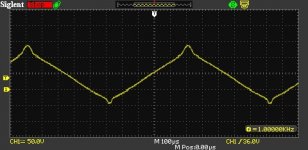 Grid at Clip.jpg45.4 KB · Views: 132
Grid at Clip.jpg45.4 KB · Views: 132 -
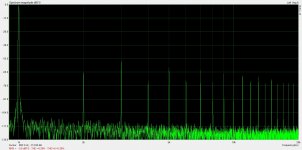 35W.jpg266.7 KB · Views: 132
35W.jpg266.7 KB · Views: 132 -
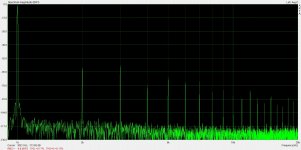 30W.jpg263.4 KB · Views: 144
30W.jpg263.4 KB · Views: 144 -
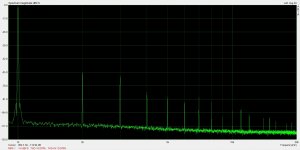 20W.jpg206.4 KB · Views: 135
20W.jpg206.4 KB · Views: 135 -
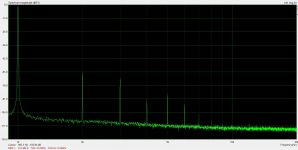 10W.jpg200.2 KB · Views: 149
10W.jpg200.2 KB · Views: 149 -
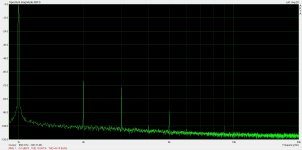 5W.jpg202 KB · Views: 132
5W.jpg202 KB · Views: 132 -
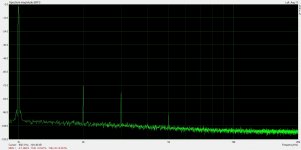 2W.jpg205 KB · Views: 131
2W.jpg205 KB · Views: 131 -
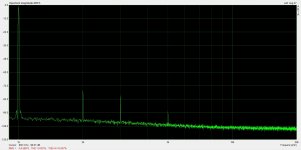 1W.jpg196.4 KB · Views: 141
1W.jpg196.4 KB · Views: 141 -
 500mW.jpg190.2 KB · Views: 139
500mW.jpg190.2 KB · Views: 139 -
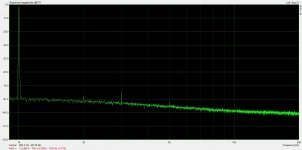 100mW.jpg189.4 KB · Views: 195
100mW.jpg189.4 KB · Views: 195
Results above are with an early Eimac 100TH with the finned anode. I tried subbing in another tube (a newer Lewis & Kaufmann) and got 0.020% @ 1W and 0.041% @ 5W.
So, results vary somewhat with the particular tube.
I plan on testing the tubes I have in order of gain, highest to lowest.
Next up will be 327A, then VT-127A, then I'll probably buy a Chinese 211 and see how that does.
So, results vary somewhat with the particular tube.
I plan on testing the tubes I have in order of gain, highest to lowest.
Next up will be 327A, then VT-127A, then I'll probably buy a Chinese 211 and see how that does.
Attachments
SpreadSpectrum, Very nice results indeed. I am impressed with the watts versus distortion your 100th has produced. I have never worked with a 100th tube. May want to do this further down the road. One never knows....Mickeystan
Yeah, the 100TH exceeded my expectations by a good margin, and I love the way they look.
I'm guessing that pretty much any high-impedance triode will give similar results, though. The 826 did really well. I originally considered the topology after wondering if there wasn't an easy way of making a tube like an 811A perform better than a 300B.
I've been just hunting for bargains on high impedance tungsten-filament triodes on eBay. There are lots of types that don't seem to have much demand and can be bought for pretty cheap. The crazier they look, the better (I think).
I'm guessing that pretty much any high-impedance triode will give similar results, though. The 826 did really well. I originally considered the topology after wondering if there wasn't an easy way of making a tube like an 811A perform better than a 300B.
I've been just hunting for bargains on high impedance tungsten-filament triodes on eBay. There are lots of types that don't seem to have much demand and can be bought for pretty cheap. The crazier they look, the better (I think).
- Home
- Amplifiers
- Tubes / Valves
- Corona: An Ultra-Low Distortion A2 DHT SE Amp Prototype
